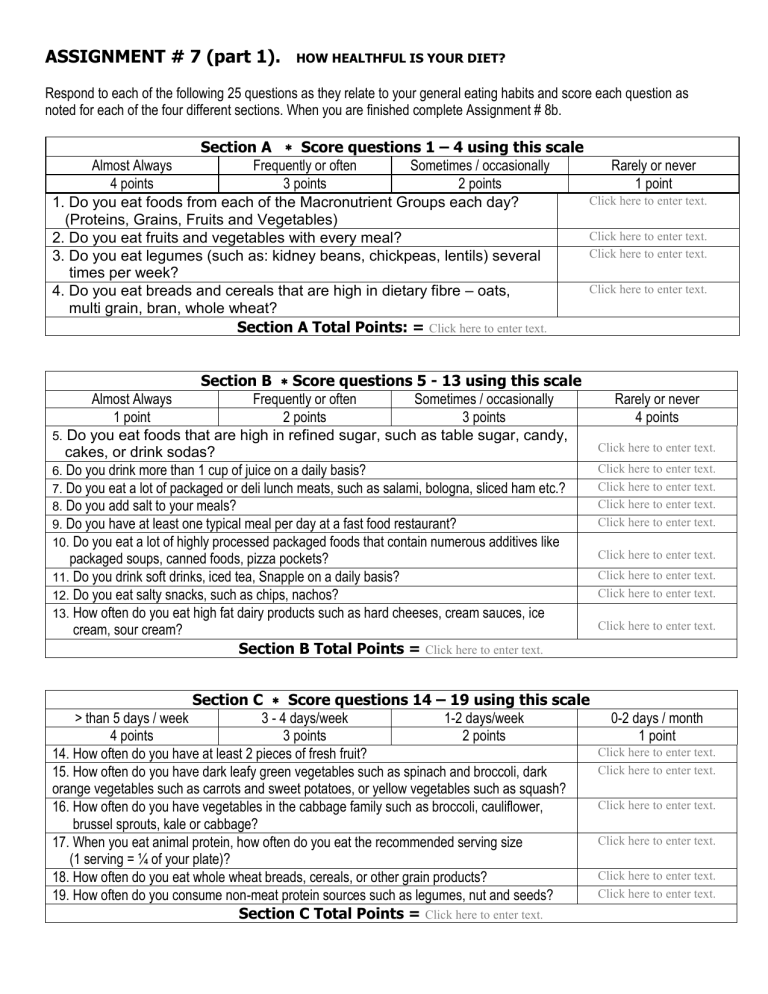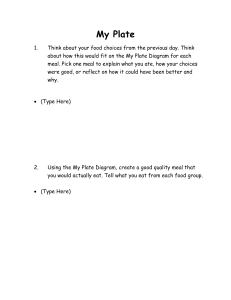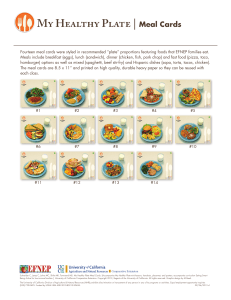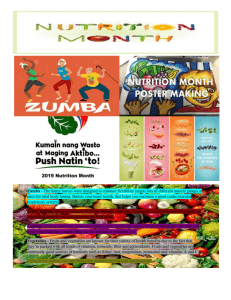
ASSIGNMENT # 7 (part 1). HOW HEALTHFUL IS YOUR DIET? Respond to each of the following 25 questions as they relate to your general eating habits and score each question as noted for each of the four different sections. When you are finished complete Assignment # 8b. Section A Score questions 1 – 4 using this scale Almost Always Frequently or often Sometimes / occasionally 4 points 3 points 2 points 1. Do you eat foods from each of the Macronutrient Groups each day? (Proteins, Grains, Fruits and Vegetables) 2. Do you eat fruits and vegetables with every meal? 3. Do you eat legumes (such as: kidney beans, chickpeas, lentils) several times per week? 4. Do you eat breads and cereals that are high in dietary fibre – oats, multi grain, bran, whole wheat? Section A Total Points: = Click here to enter text. Rarely or never 1 point Click here to enter text. Click here to enter text. Click here to enter text. Click here to enter text. Section B Score questions 5 - 13 using this scale Almost Always Frequently or often Sometimes / occasionally 1 point 2 points 3 points 5. Do you eat foods that are high in refined sugar, such as table sugar, candy, cakes, or drink sodas? 6. Do you drink more than 1 cup of juice on a daily basis? 7. Do you eat a lot of packaged or deli lunch meats, such as salami, bologna, sliced ham etc.? 8. Do you add salt to your meals? 9. Do you have at least one typical meal per day at a fast food restaurant? 10. Do you eat a lot of highly processed packaged foods that contain numerous additives like packaged soups, canned foods, pizza pockets? 11. Do you drink soft drinks, iced tea, Snapple on a daily basis? 12. Do you eat salty snacks, such as chips, nachos? 13. How often do you eat high fat dairy products such as hard cheeses, cream sauces, ice cream, sour cream? Section B Total Points = Click here to enter text. Section C Score questions 14 – 19 using this scale > than 5 days / week 3 - 4 days/week 1-2 days/week 4 points 3 points 2 points 14. How often do you have at least 2 pieces of fresh fruit? 15. How often do you have dark leafy green vegetables such as spinach and broccoli, dark orange vegetables such as carrots and sweet potatoes, or yellow vegetables such as squash? 16. How often do you have vegetables in the cabbage family such as broccoli, cauliflower, brussel sprouts, kale or cabbage? 17. When you eat animal protein, how often do you eat the recommended serving size (1 serving = ¼ of your plate)? 18. How often do you eat whole wheat breads, cereals, or other grain products? 19. How often do you consume non-meat protein sources such as legumes, nut and seeds? Section C Total Points = Click here to enter text. Rarely or never 4 points Click here to enter text. Click here to enter text. Click here to enter text. Click here to enter text. Click here to enter text. Click here to enter text. Click here to enter text. Click here to enter text. Click here to enter text. 0-2 days / month 1 point Click here to enter text. Click here to enter text. Click here to enter text. Click here to enter text. Click here to enter text. Click here to enter text. 20. 21. 22. 23 24 25 Section D Score questions 20 - 25 as indicated Which type of milk do you 4 points - skim or non-fat milk normally drink? 3 points - 1 % milk 2 points - 2 % milk 1 point - whole / homogenized milk Which of the following 4 points - fish or plant protein such as beans protein sources do you 3 points - chicken, turkey or other poultry normally select? 2 points - red meat, such as beef or pork 1 point - hard cheeses What do you normally put 4 points - nothing or low-sugar spread on bread? 3 points – non hydrogenated margarine 2 -points - butter 1 point – hydrogenated margarine What do you normally have 4 points - fresh fruit for sweet snacks or desert? 3 points - yogurt 2 points - sherbet or ice milk 1 point - ice cream, cakes, pastries, chocolate What do you normally have 4 points - tuna fish in water on a sandwich? 3 points – fresh meat like chicken or turkey 2 points - roast beef or peanut butter 1 point - packaged, processed lunchmeat – salami, bologna, pastrami How do you normally cook 4 points - bake, broil or steamed your foods? 3 points – pan fry in olive, canola, peanut, avocado oil 2 points – pan fry vegetable oils – corn, sunflower, safflower 1 point - use butter, lard, coconut or palm oil Section D Total Points = Click here to enter text. Click here to enter text. Click here to enter text. Click here to enter text. Click here to enter text. Click here to enter text. Click here to enter text. Add up scores from sections A - D Total Nutrition Score = Click here to enter text. Rating (refer to table below) = Click here to enter text. Use the following scoring table as a guide to your dietary habits. You should strive to score in the good to excellent category. Check those answers in the 1 to 2 point categories for guidelines to improvement. 90 - 100 75 - 89 60 -74 45 - 59 24 - 44 Excellent Good Average Below Average Poor Proceed to Part 2 Adapted from: Williams, Melvin H. Lifetime Fitness & Wellness, (1996). Madison, WI: Brown & Benchmark Publishers, p. 275-276 of 368 pages. ASSIGNMENT # 7 (part 2) - PERSONAL NUTRITION MODIFICATIONS Step 1. Step 2: Step 3: Review your answers from The Health Questionnaire and highlight any areas where you scored 1-2 points. Complete the table below by referring to the areas where you score 1-2 points. Identify the problem or habit that needs to be improved. Identify specific nutrition changes you can make to improve in that area. Question # from Questionnaire Identify the problem What can I do to improve my eating habits? What specific nutrition change can I make? Click here to enter text. Click here to enter text. Click here to enter text. Click here to enter text. Click here to enter text. Click here to enter text. Click here to enter text. Click here to enter text. Click here to enter text. Click here to enter text. Click here to enter text. Click here to enter text. Click here to enter text. Click here to enter text. Click here to enter text. Click here to enter text. Click here to enter text. Click here to enter text. Click here to enter text. Click here to enter text. Click here to enter text. Click here to enter text. Click here to enter text. Click here to enter text. Click here to enter text. Click here to enter text. Click here to enter text. Click here to enter text. Click here to enter text. Click here to enter text. My Plate – Nutrition Assignment Task: With a friend or family member, create (plan, prepare, cook and serve) a dinner meal that is a Healthy Balanced Meal (Plate) as shown below – following the Canada Food Guide. Criteria: You must be the main person in planning, preparing, cooking and serving the dish. The meal must be home-made, made from scratch (not pre-packaged). Use food items that you would usually eat. You must submit a video of you preparing and cooking the meal. You must be in the video preparing and cooking the meal. Show before and after pictures of how your meal fits the Canada Food Guide. (Refer to this link for an example https://youtu.be/9FG4d-2tECo ) You must submit a picture of your final dish. If you mix the ingredients, you must take a picture, before preparing the dish, to show that it is a plate that follows the Canada food guide, as well as the final product. (Refer to this link for an example https://youtu.be/hknXiyFwUEA ) Label your pictures, indicating the different parts of the plate – vegetables, fruits, whole grains, healthy proteins. Refer to the nutrition recommendations and guidelines from the Harvard Chan medical school using the following link: https://www.hsph.harvard.edu/nutritionsource or the 2020 Canada Food Guide Healthy Eating Plate https://food-guide.canada.ca/en/ Submit all pictures and video links on the next page. Save the document as PDF and upload your assignment. (Only submit the Video and Photo Submission page) Video and Photo Submission Enter video hyperlink of the chefs preparing the meal Insert Labelled Photos of the Final Meal (Before and After)





